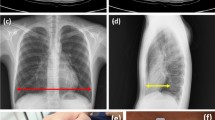Abstract
Objective
Surgical repair of pectus excavatum (PE) in childhood is a well-established procedure. Previously used operative techniques to correct PE were largely based on the Ravitch technique. Since about 10 years, the minimally invasive repair (MIRPE) by Nuss is well established. Conservative treatment with the vacuum bell to elevate the funnel in patients with PE represents a potential alternative to surgery in selected patients.
Methods
A suction cup is used to create a vacuum at the anterior chest wall. Three different sizes of vacuum bell exist which are selected according to the individual patients age. When creating the vacuum, the lift of the sternum is obvious and remains for a different time period. The device should be used for a minimum of 30 min (twice/day), and may be used up to a maximum of several hours daily.
Results
One hundred and thirty-three patients (110 males, 23 females) aged from 3 to 61 years (median 16.21 years) used the vacuum bell for 1 to a maximum of 36 months. Computed tomographic scans showed that the device lifted the sternum and ribs immediately. In addition, this was confirmed thoracoscopically during the MIRPE procedure. One hundred and five patients showed a permanent lift of the sternum for more than 1 cm after 3 months of daily application. Thirteen patients stopped the application and underwent MIRPE. Relevant side effects were not noted.
Conclusion
The vacuum bell has proved to be an alternative therapeutic option in selected patients suffering from PE. The initial results proved to be dramatic, but long-term results are so far lacking, and further evaluation and follow-up studies are necessary.




Similar content being viewed by others
References
Molik KA, Engum SA, Rescorla FJ, West KW, Scherer LR, Grosfeld JL (2001) Pectus excavatum repair: experience with standard and minimal invasive techniques. J Pediatr Surg 36:324–328
Ravitch MM (1949) The operative treatment of pectus excavatum. Ann Surg 129:429–444
Nuss D, Kelly RE, Croitoru DP, Katz ME (1998) A 10-year review of a minimally invasive technique for the correction of pectus excavatum. J Pediatr Surg 33:545–552
Croitoru DP, Kelly RE, Goretsky MJ, Lawson ML, Swoveland B, Nuss D (2002) Experience and modification update for the minimally invasive Nuss technique for pectus excavatum repair in 303 patients. J Pediatr Surg 37:437–445
Hosie S, Sitkiewicz T, Petersen C, Göbel P, Schaarschmidt K, Till H et al (2002) Minimally invasive repair of pectus excavatum—the Nuss procedure. A European multicentre experience. Eur J Pediatr Surg 12:235–238
Nuss D, Croitoru DP, Kelly RE, Goretsky MJ, Nuss KJ, Gustin TS (2002) Review and discussion of the complications of minimally invasive pectus excavatum repair. Eur J Pediatr Surg 12:230–234
Haecker F-M, Bielek J, von Schweinitz D (2003) Minimally invasive repair of pectus excavatum (MIRPE): the Basel experience. Swiss Surg 9:289–295
Park HJ, Lee SY, Lee CS (2004) Complications associated with the Nuss procedure: analysis of risk factors and suggested measures for prevention of complications. J Pediatr Surg 39:391–395
Dzielicki J, Korlacki W, Janicka I, Dzielicka E (2006) Difficulties and limitations in minimally invasive repair of pectus excavatum—6 years experiences with Nuss technique. Eur J Cardio-Thorac 30:801–804
Shin S, Goretsky MJ, Kelly RE, Gustin T, Nuss D (2007) Infectious complications after the Nuss repair in a series of 863 patients. J Pediatr Surg 42:87–92
Berberich T, Haecker F-M, Kehrer B, Erb T, Günthard J, Hammer J, Jenny P (2004) Postcardiotomy syndrome after minimally invasive repair of pectus excavatum. J Pediatr Surg 39:e1–e3
Van Renterghem KM, von Bismarck S, Bax NMA, Fleer A, Hoellwarth M (2005) Should an infected Nuss bar be removed? J Pediatr Surg 40:670–673
Barakat MJ, Morgan JA (2004) Haemopericardium causing cardiac tamponade: a late complication of pectus excavatum repair. Heart 90:e22–e23
Barsness K, Bruny J, Janik JS, Partrick DA (2005) Delayed near-fatal hemorrhage after Nuss bar displacement. J Pediatr Surg 40:E5–E6
Hoel TN, Rein KA, Svennevig JL (2006) A life-threatening complication of the Nuss-procedure for pectus excavatum. Ann Thorac Surg 81:370–372
Adam LA, Lawrence JL, Meehan JJ (2008) Erosion of the Nuss bar into the internal mammary artery 4 months after minimally invasive repair of pectus excavatum. J Pediatr Surg 43:394–397
Gips H, Zaitsev K, Hiss J (2008) Cardiac perforation by a pectus bar after surgical correction of pectus excavatum: case report and review of the literature. Pediatr Surg Int 24:617–620
Haecker F-M, Berberich T, Mayr J, Gambazzi F (2009) Near-fatal bleeding after transmyocardial ventricle lesion during removal of the pectus bar after the Nuss procedure. J Thorac Cardiovasc Surg 138 (5):1240–1. Epub 2008 Sep 19
Lange F (1910) Thoraxdeformitäten. In: Pfaundler M, Schlossmann A (eds) Handbuch der Kinderheilkunde, Vol V. Chirurgie und Orthopädie im Kindesalter. FCW Vogel, Leipzig, p 157
Haecker F-M, Mayr J (2006) The vacuum bell for treatment of pectus excavatum: an alternative to surgical correction? Eur J Cardio-Thorac 29:557–561
Haecker F-M (2009) Conservative treatment of pectus excavatum with the vacuum bell by E. Klobe: an alternative to the metal holder? Orthop praxis 45:183–189
Schier F, Bahr M, Klobe E (2005) The vacuum chest wall lifter: an innovative, nonsurgical addition to the management of pectus excavatum. J Pediatr Surg 40:496–500
Chang PY, Chang CH, Lai JY, Chen JC, Perng DB, Zeng Q (2010) A method for the non-invasive assessment of chest wall growth in pectus excavatum patients. Eur J Pediatr Surg 20:82–84
Author information
Authors and Affiliations
Corresponding author
Rights and permissions
About this article
Cite this article
Haecker, FM. The vacuum bell for conservative treatment of pectus excavatum: the Basle experience. Pediatr Surg Int 27, 623–627 (2011). https://doi.org/10.1007/s00383-010-2843-7
Published:
Issue Date:
DOI: https://doi.org/10.1007/s00383-010-2843-7




